Revealing the Mismatch Between Residents’ SWB and Residential Environment Quality in Old and New Urban Areas: Community-Level Evidence from Two Historic Cities in China
Abstract
1. Introduction
2. Literature Review
2.1. The Impact of Urban Environment on SWB
2.2. Measurement of Residents’ SWB
2.3. Measurement of Environmental Perception Quality
2.4. Theoretical Framework
3. Data and Methodology
3.1. Study Area
3.2. Research Framework
3.3. Data Collection
4. Methodology
4.1. NLP Sentiment Analysis
4.2. FCN Semantic Segmentation
4.3. SVM Perception Prediction
4.4. Calculation of Perception Bias
4.5. Spatial Autocorrelation
4.6. XGBoost Regression Model Combining Spatial Features
4.7. Shapley Explanatory Model
5. Results and Analysis
5.1. Spatial Distribution and Clustering Characteristics of Perception Bias
5.2. Feature Selection and Model Training
5.3. Variables Importance
5.4. Nonlinear Association Analys
6. Discussion
6.1. Perceptual Bias and the Well-Being Paradox
6.2. Spatial Mechanisms of Density and Well-Being
- Population and facility density: Population, street, and commercial/tourism facility densities exhibit inverted-U or bimodal curves. Moderate density enhances convenience and social interaction, reducing perceptual bias; once beyond a threshold, congestion and noise diminish SWB, while very low density (e.g., in peripheral zones) equally suppresses SWB due to weak accessibility.
- Greenness and openness: Both visual greenness (street-level vegetation) and NDVI show positive associations with well-being at low levels but diminishing or negative effects when excessive, reflecting a “rise-then-fall” pattern as maintenance costs and facility scarcity offset comfort gains.
- Housing price and socioeconomic burden: Housing price correlates negatively with well-being beyond a critical point, suggesting that cost stress mediates the benefit of visually improved environments.
- Road network and transport accessibility: Street density, accessibility, and walkability exhibit nonlinear returns: improvements from low to moderate levels generate substantial gains in SWB—via better network connectivity and expanded pedestrian provision—whereas excessive capacity expansion can induce congestion and overconcentration.
6.3. Inter-City Differences and Policy Implications
- Beijing should focus on alleviating the well-being gap between the core and periphery. This entails extending rail transit and public services to suburban areas to mitigate commuting burdens while avoiding over-aestheticized, capital-driven redevelopment that displaces long-standing communities. Preserving everyday life functions and neighborhood networks in the old city supports a “cultural-continuity” renewal path.
- Nanjing, by contrast, must coordinate functional and cultural integration between its old and new districts. Policy efforts should maintain the social vitality of historic neighborhoods—preventing over-tourism and commodification that erode place attachment—while ensuring the new southern districts achieve full provision of education, health, and commercial services. Such measures will avert “high-quality environment but low social identity” hollow growth and promote a “culture–function co-evolution” model.
6.4. Limitation
7. Conclusions
Author Contributions
Funding
Data Availability Statement
Conflicts of Interest
Abbreviations
| SWB | Subjective Well-Being |
| REQ | Residential Environment Quality |
| PB | Perceptual Bias |
| BE | Built Environment |
| NDVI | Normalized Difference Vegetation Index |
| POI | Point of Interest |
| NLP | Natural Language Processing |
| SVM | Support Vector Machine |
| FCN | Fully Convolutional Network |
| SHAP | SHapley Additive exPlanations |
| OLS | Ordinary Least Squares |
| SEM | Spatial Error Model |
| GBDT | Gradient Boosted Decision Tree |
References
- Veenhoven, R. Is Happiness Relative? Soc. Indic. Res. 1991, 24, 1–34. [Google Scholar] [CrossRef]
- Diener, E.; Inglehart, R.; Tay, L. Theory and Validity of Life Satisfaction Scales. Soc. Indic. Res. 2013, 112, 497–527. [Google Scholar] [CrossRef]
- Dong, G.; Zhang, Z.; Zhang, H.; Wu, L. Geographical Match of Objective and Subjective Measures of Well-Being at an Intra-City Scale. Appl. Geogr. 2024, 167, 103290. [Google Scholar] [CrossRef]
- Dong, Y.; Li, F.; Cao, J.; Dong, W. What Neighborhood Factors Are Critical to Resident Satisfaction with Old Neighborhoods? An Integration of Ground Theory and Impact Asymmetry Analysis. Cities 2023, 141, 104460. [Google Scholar] [CrossRef]
- Huang, Y.; Yi, D.; Clark, W.A.V. Subjective Wellbeing in 21st Century China: A Multi-Level Multi-Dimensional Perspective on Urban-Rural Disparities. Appl. Geogr. 2023, 159, 103071. [Google Scholar] [CrossRef]
- Millward, H.; Spinney, J. Urban–Rural Variation in Satisfaction with Life: Demographic, Health, and Geographic Predictors in Halifax, Canada. Appl. Res. Qual. Life 2013, 8, 279–297. [Google Scholar] [CrossRef]
- Ettema, D.; Schekkerman, M. How Do Spatial Characteristics Influence Well-Being and Mental Health? Comparing the Effect of Objective and Subjective Characteristics at Different Spatial Scales. Travel Behav. Soc. 2016, 5, 56–67. [Google Scholar] [CrossRef]
- Kent, J.L.; Ma, L.; Mulley, C. The Objective and Perceived Built Environment: What Matters for Happiness? Cities Health 2017, 1, 59–71. [Google Scholar] [CrossRef]
- Lovejoy, K.; Handy, S.; Mokhtarian, P. Neighborhood Satisfaction in Suburban versus Traditional Environments: An Evaluation of Contributing Characteristics in Eight California Neighborhoods. Landsc. Urban Plan. 2010, 97, 37–48. [Google Scholar] [CrossRef]
- Biswas-Diener, R.; Diener, E. Making the Best of a Bad Situation: Satisfaction in the Slums of Calcutta. Soc. Indic. Res. 2001, 55, 329–352. [Google Scholar] [CrossRef]
- Phillips, D.R.; Cheng, K.H.C.; Yeh, A.G.O.; Siu, O.-L. Person—Environment (P—E) Fit Models and Psychological Well-Being Among Older Persons in Hong Kong. Environ. Behav. 2010, 42, 221–242. [Google Scholar] [CrossRef]
- Scannell, L.; Gifford, R. Defining Place Attachment: A Tripartite Organizing Framework. J. Environ. Psychol. 2010, 30, 1–10. [Google Scholar] [CrossRef]
- Mokhtarian, P.L.; Cao, X. Examining the Impacts of Residential Self-Selection on Travel Behavior: A Focus on Methodologies. Transp. Res. Part B Methodol. 2008, 42, 204–228. [Google Scholar] [CrossRef]
- Stutzer, A.; Frey, B.S. Stress That Doesn’t Pay: The Commuting Paradox*. Scand. J. Econ. 2008, 110, 339–366. [Google Scholar] [CrossRef]
- Deb, S.; Okulicz-Kozaryn, A. Exploring the Association of Urbanisation and Subjective Well-Being in India. Cities 2023, 132, 104068. [Google Scholar] [CrossRef]
- Ozbilen, B.; Akar, G. Designing Pandemic Resilient Cities: Exploring the Impacts of the Built Environment on Infection Risk Perception and Subjective Well-Being. Travel Behav. Soc. 2023, 30, 105–117. [Google Scholar] [CrossRef] [PubMed]
- Kubiszewski, I.; Jarvis, D.; Zakariyya, N. Spatial Variations in Contributors to Life Satisfaction: An Australian Case Study. Ecol. Econ. 2019, 164, 106345. [Google Scholar] [CrossRef]
- Ma, S.; Wang, B.; Liu, W.; Zhou, H.; Wang, Y.; Li, S. Assessment of Street Space Quality and Subjective Well-Being Mismatch and Its Impact, Using Multi-Source Big Data. Cities 2024, 147, 104797. [Google Scholar] [CrossRef]
- Credit, K.; Lehnert, M. A Structured Comparison of Causal Machine Learning Methods to Assess Heterogeneous Treatment Effects in Spatial Data. J. Geogr. Syst. 2023, 26, 483–510. [Google Scholar] [CrossRef]
- Liu, X.; Kounadi, O.; Zurita-Milla, R. Incorporating Spatial Autocorrelation in Machine Learning Models Using Spatial Lag and Eigenvector Spatial Filtering Features. Int. J. Geo-Inf. 2022, 11, 242. [Google Scholar] [CrossRef]
- Yoshida, T.; Murakami, D.; Seya, H. Spatial Prediction of Apartment Rent Using Regression-Based and Machine Learning-Based Approaches with a Large Dataset. J. Real Estate Financ. Econ. 2024, 69, 1–28. [Google Scholar] [CrossRef]
- Credit, K. Spatial Models or Random Forest? Evaluating the Use of Spatially Explicit Machine Learning Methods to Predict Employment Density around New Transit Stations in Los Angeles. Geogr. Anal. 2022, 54, 58–83. [Google Scholar] [CrossRef]
- Chen, J.; Chen, S. Mental Health Effects of Perceived Living Environment and Neighborhood Safety in Urbanizing China. Habitat. Int. 2015, 46, 101–110. [Google Scholar] [CrossRef]
- Appleton, S.; Song, L. Life Satisfaction in Urban China: Components and Determinants. World Dev. 2008, 36, 2325–2340. [Google Scholar] [CrossRef]
- Zhang, P. Happiness Inequality Has a Kuznets-Style Relation with Economic Growth in China. Sci. Rep. 2022, 12, 15712. [Google Scholar] [CrossRef]
- Jiang, Y.; Chen, L.; Xie, Y.; Li, Y.; Li, T. Subjective Well-Being of Historical Neighborhood Residents in Beijing: The Impact on the Residential Environment. Sustainability 2023, 15, 1847. [Google Scholar] [CrossRef]
- Wang, F.; Wang, D. Geography of Urban Life Satisfaction: An Empirical Study of Beijing. Travel Behav. Soc. 2016, 5, 14–22. [Google Scholar] [CrossRef]
- Rodgers, W.L. Density, Crowding, and Satisfaction with the Residential Environment. Soc. Indic. Res. 1982, 10, 75–102. [Google Scholar] [CrossRef]
- Mouratidis, K. Compact City, Urban Sprawl, and Subjective Well-Being. Cities 2019, 92, 261–272. [Google Scholar] [CrossRef]
- Kyttä, M.; Broberg, A.; Haybatollahi, M.; Schmidt-Thomé, K. Urban Happiness: Context-Sensitive Study of the Social Sustainability of Urban Settings. Environ. Plan. B-Plan. Des. 2016, 43, 34–57. [Google Scholar] [CrossRef]
- Diener, E. Subjective Well-Being. Psychol. Bull. 1984, 95, 542–575. [Google Scholar] [CrossRef]
- Voukelatou, V.; Gabrielli, L.; Miliou, I.; Cresci, S.; Sharma, R.; Tesconi, M.; Pappalardo, L. Measuring Objective and Subjective Well-Being: Dimensions and Data Sources. Int. J. Data Sci. Anal. 2021, 11, 279–309. [Google Scholar] [CrossRef]
- Pavot, W.; Diener, E. The Affective and Cognitive Context of Self-Reported Measures of Subjective Well-Being. Soc. Indic. Res. 1993, 28, 1–20. [Google Scholar] [CrossRef]
- Bowman, N.A.; Schuldt, J.P. Effects of Item Order and Response Options in College Student Surveys. New Dir. Institutional Res. 2014, 2014, 99–109. [Google Scholar] [CrossRef]
- Ghermandi, A.; Sinclair, M. Passive Crowdsourcing of Social Media in Environmental Research: A Systematic Map. Glob. Environ. Change 2019, 55, 36–47. [Google Scholar] [CrossRef]
- Huai, S.; Van De Voorde, T. Which Environmental Features Contribute to Positive and Negative Perceptions of Urban Parks? A Cross-Cultural Comparison Using Online Reviews and Natural Language Processing Methods. Landsc. Urban Plan. 2022, 218, 104307. [Google Scholar] [CrossRef]
- Wang, R.; Browning, M.H.E.M.; Qin, X.; He, J.; Wu, W.; Yao, Y.; Liu, Y. Visible Green Space Predicts Emotion: Evidence from Social Media and Street View Data. Appl. Geogr. 2022, 148, 102803. [Google Scholar] [CrossRef]
- Li, D.; Shen, W. Regional Happiness and Corporate Green Innovation: A Financing Constraints Perspective. Sustainability 2022, 14, 2263. [Google Scholar] [CrossRef]
- Lin, Y.; Wood, S.A.; Lawler, J.J. The Relationship between Natural Environments and Subjective Well-Being as Measured by Sentiment Expressed on Twitter. Landsc. Urban Plan. 2022, 227, 104539. [Google Scholar] [CrossRef]
- Li, S.; Ma, S.; Tong, D.; Jia, Z.; Li, P.; Long, Y. Associations between the Quality of Street Space and the Attributes of the Built Environment Using Large Volumes of Street View Pictures. Environ. Plan. B Urban Anal. City Sci. 2022, 49, 1197–1211. [Google Scholar] [CrossRef]
- Zhu, Y.; Su, F.; Han, X.; Fu, Q.; Liu, J. Uncovering the Drivers of Gender Inequality in Perceptions of Safety: An Interdisciplinary Approach Combining Street View Imagery, Socio-Economic Data and Spatial Statistical Modelling. Int. J. Appl. Earth Obs. Geoinf. 2024, 134, 104230. [Google Scholar] [CrossRef]
- Dubey, A.; Naik, N.; Parikh, D.; Raskar, R.; Hidalgo, C.A. Deep Learning the City: Quantifying Urban Perception at a Global Scale. In Computer Vision—ECCV 2016; Leibe, B., Matas, J., Sebe, N., Welling, M., Eds.; Lecture Notes in Computer Science; Springer International Publishing: Cham, Switzerland, 2016; Volume 9905, pp. 196–212. ISBN 978-3-319-46447-3. [Google Scholar]
- Zhang, F.; Zhou, B.; Liu, L.; Liu, Y.; Fung, H.H.; Lin, H.; Ratti, C. Measuring Human Perceptions of a Large-Scale Urban Region Using Machine Learning. Landsc. Urban Plan. 2018, 180, 148–160. [Google Scholar] [CrossRef]
- Wei, J.; Yue, W.; Li, M.; Gao, J. Mapping Human Perception of Urban Landscape from Street-View Images: A Deep-Learning Approach. Int. J. Appl. Earth Obs. Geoinf. 2022, 112, 102886. [Google Scholar] [CrossRef]
- Yao, Y.; Liang, Z.; Yuan, Z.; Liu, P.; Bie, Y.; Zhang, J.; Wang, R.; Wang, J.; Guan, Q. A Human-Machine Adversarial Scoring Framework for Urban Perception Assessment Using Street-View Images. Int. J. Geogr. Inf. Sci. 2019, 33, 2363–2384. [Google Scholar] [CrossRef]
- Zhang, F.; Fan, Z.; Kang, Y.; Hu, Y.; Ratti, C. “Perception Bias”: Deciphering a Mismatch between Urban Crime and Perception of Safety. Landsc. Urban Plan. 2021, 207, 104003. [Google Scholar] [CrossRef]
- Kang, Y.; Abraham, J.; Ceccato, V.; Duarte, F.; Gao, S.; Ljungqvist, L.; Zhang, F.; Näsman, P.; Ratti, C. Assessing Differences in Safety Perceptions Using GeoAI and Survey across Neighbourhoods in Stockholm, Sweden. Landsc. Urban Plan. 2023, 236, 104768. [Google Scholar] [CrossRef]
- Kaplan, R.; Kaplan, S. The Experience of Nature: A Psychological Perspective; Cambridge University Press: Cambridge, UK; New York, NY, USA, 1989; ISBN 978-0-521-34139-4. [Google Scholar]
- Lawton, M.P.; Nahemow, L. Ecology and the Aging Process. In The Psychology of Adult Development and Aging; Eisdorfer, C., Lawton, M.P., Eds.; American Psychological Association: Washington, DC, USA, 1973; pp. 619–674. [Google Scholar]
- Leyden, K.M.; Goldberg, A.; Michelbach, P. Understanding the Pursuit of Happiness in Ten Major Cities. Urban Aff. Rev. 2011, 47, 861–888. [Google Scholar] [CrossRef]
- Benita, F.; Bansal, G.; Tunçer, B. Public Spaces and Happiness: Evidence from a Large-Scale Field Experiment. Health Place 2019, 56, 9–18. [Google Scholar] [CrossRef]
- Cloutier, S.; Pfeiffer, D. Sustainability Through Happiness: A Framework for Sustainable Development. Sustain. Dev. 2015, 23, 317–327. [Google Scholar] [CrossRef]
- Ma, J.; Dong, G.; Chen, Y.; Zhang, W. Does Satisfactory Neighbourhood Environment Lead to a Satisfying Life? An Investigation of the Association between Neighbourhood Environment and Life Satisfaction in Beijing. Cities 2018, 74, 229–239. [Google Scholar] [CrossRef]
- Kim, J.; Lee, Y.; Lee, M.-H.; Hong, S.-Y. A Comparative Study of Machine Learning and Spatial Interpolation Methods for Predicting House Prices. Sustainability 2022, 14, 9056. [Google Scholar] [CrossRef]
- Chen, Y.; Xu, C.; Ge, Y.; Zhang, X.; Zhou, Y. A 100-m Gridded Population Dataset of China’s Seventh Census Using Ensemble Learning and Geospatial Big Data. Earth Syst. Sci. Data 2024, 16, 3705–3718. [Google Scholar] [CrossRef]
- Zhou, B.; Zhao, H.; Puig, X.; Fidler, S.; Barriuso, A.; Torralba, A. Scene Parsing through ADE20K Dataset. In Proceedings of the IEEE Conference on Computer Vision and Pattern Recognition (CVPR), Nashville, TN, USA, 11–15 June 2017; pp. 633–641. [Google Scholar]
- Lundberg, S.M.; Lee, S.-I. Consistent Feature Attribution for Tree Ensembles. arXiv 2017, arXiv:1802.03888. [Google Scholar]
- McCrea, R.; Shyy, T.-K.; Stimson, R.J. Satisfied Residents in Different Types of Local Areas: Measuring What’s Most Important. Soc. Indic. Res. 2014, 118, 87–101. [Google Scholar] [CrossRef]
- Avtar, R.; Ahmad, S.; Rahman, M.M.; Alsulamy, S.; Meraj, G.; Sethi, M.; Singh, C.K.; Kharrazi, A. Impact of Urban Density on Human Well-Being and Sustainable Development in Delhi, India. Sci. Rep. 2025, 15, 33717. [Google Scholar] [CrossRef]
- Ilieva, R.T.; McPhearson, T. Social-Media Data for Urban Sustainability. Nat. Sustain. 2018, 1, 553–565. [Google Scholar] [CrossRef]
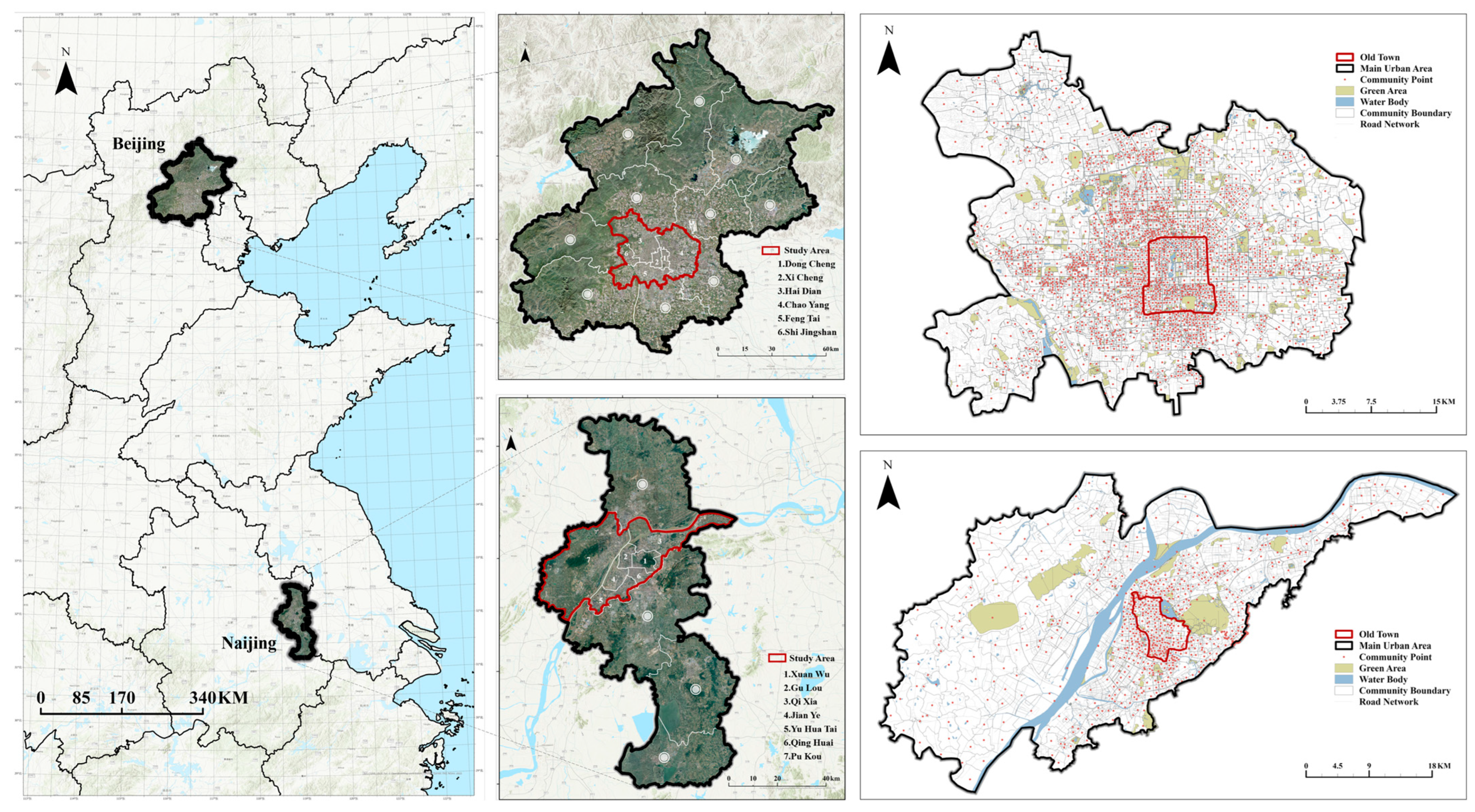
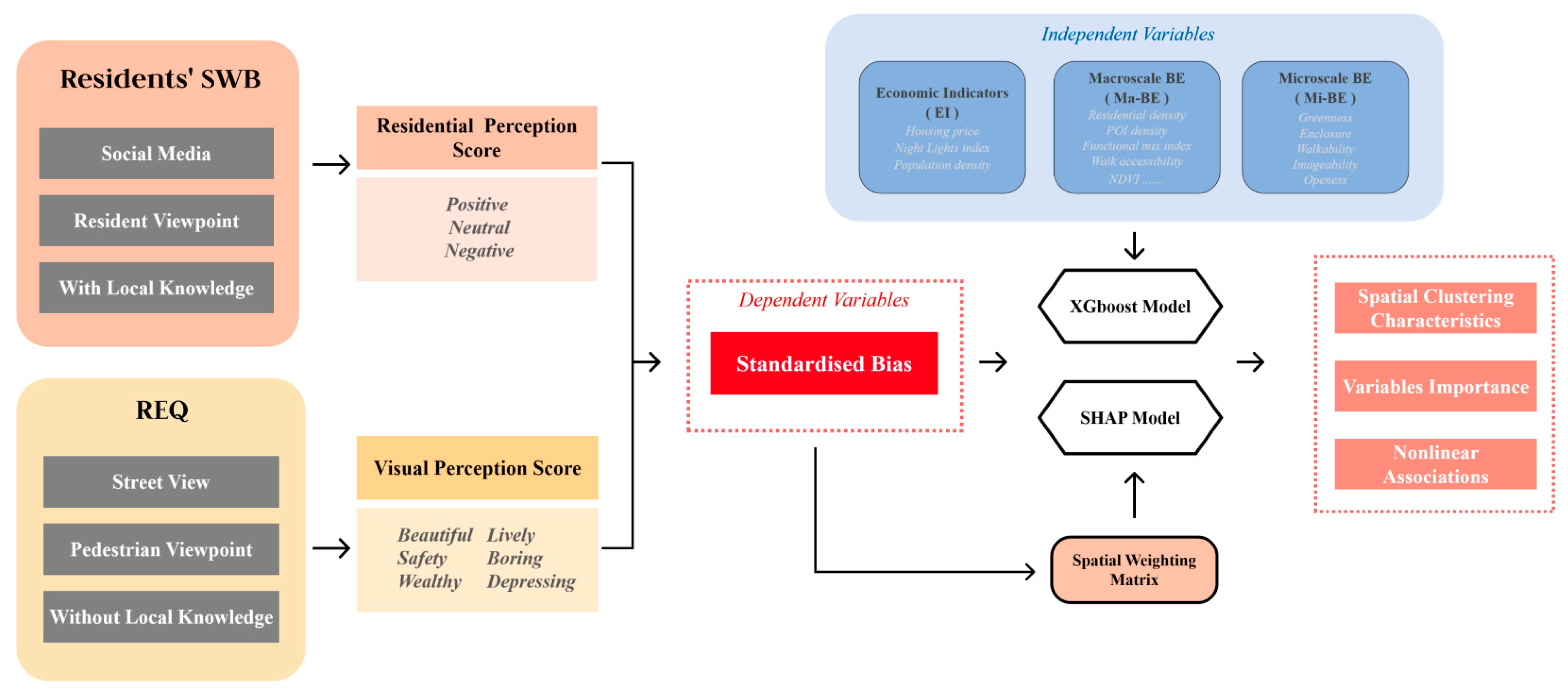



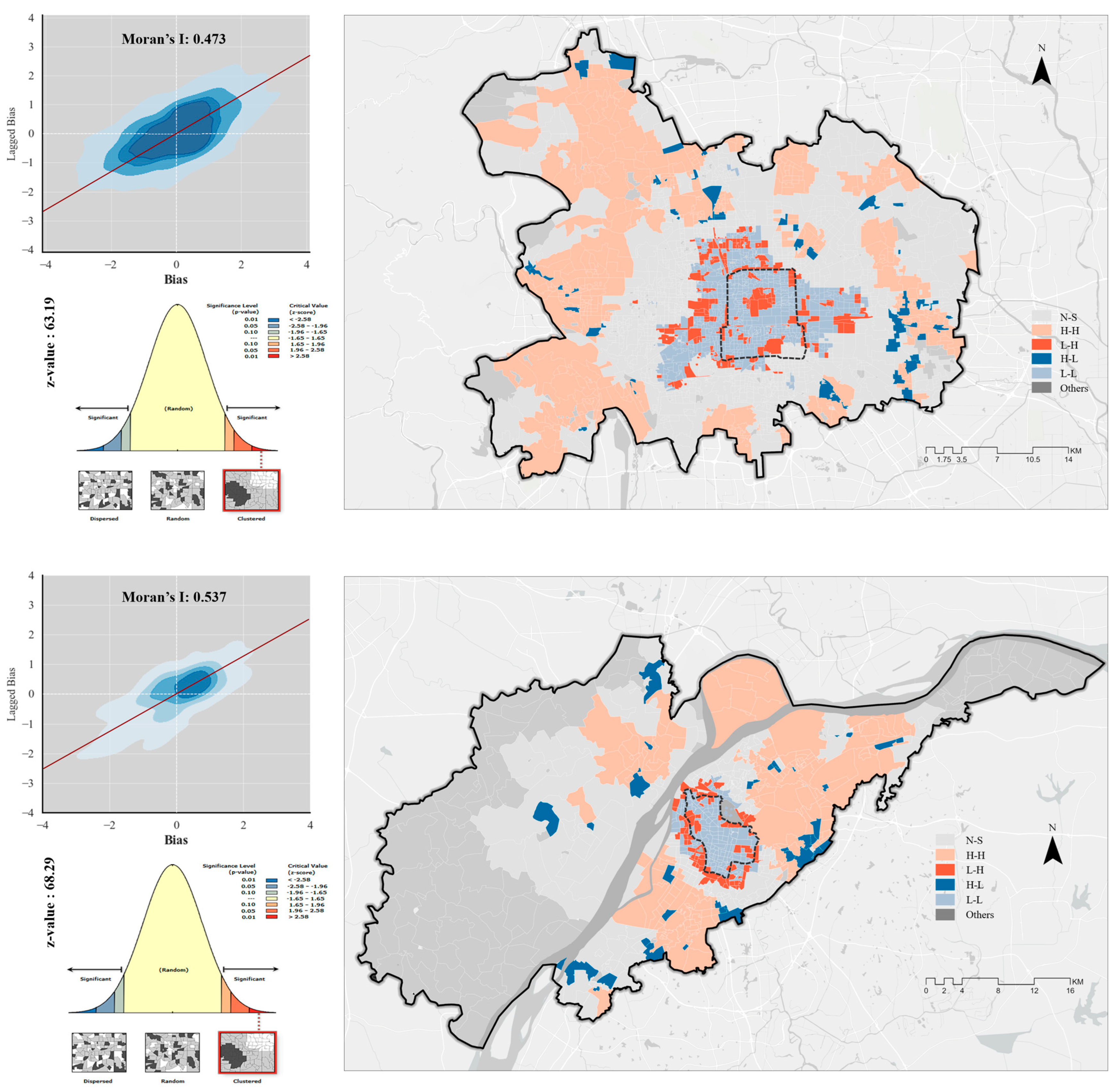
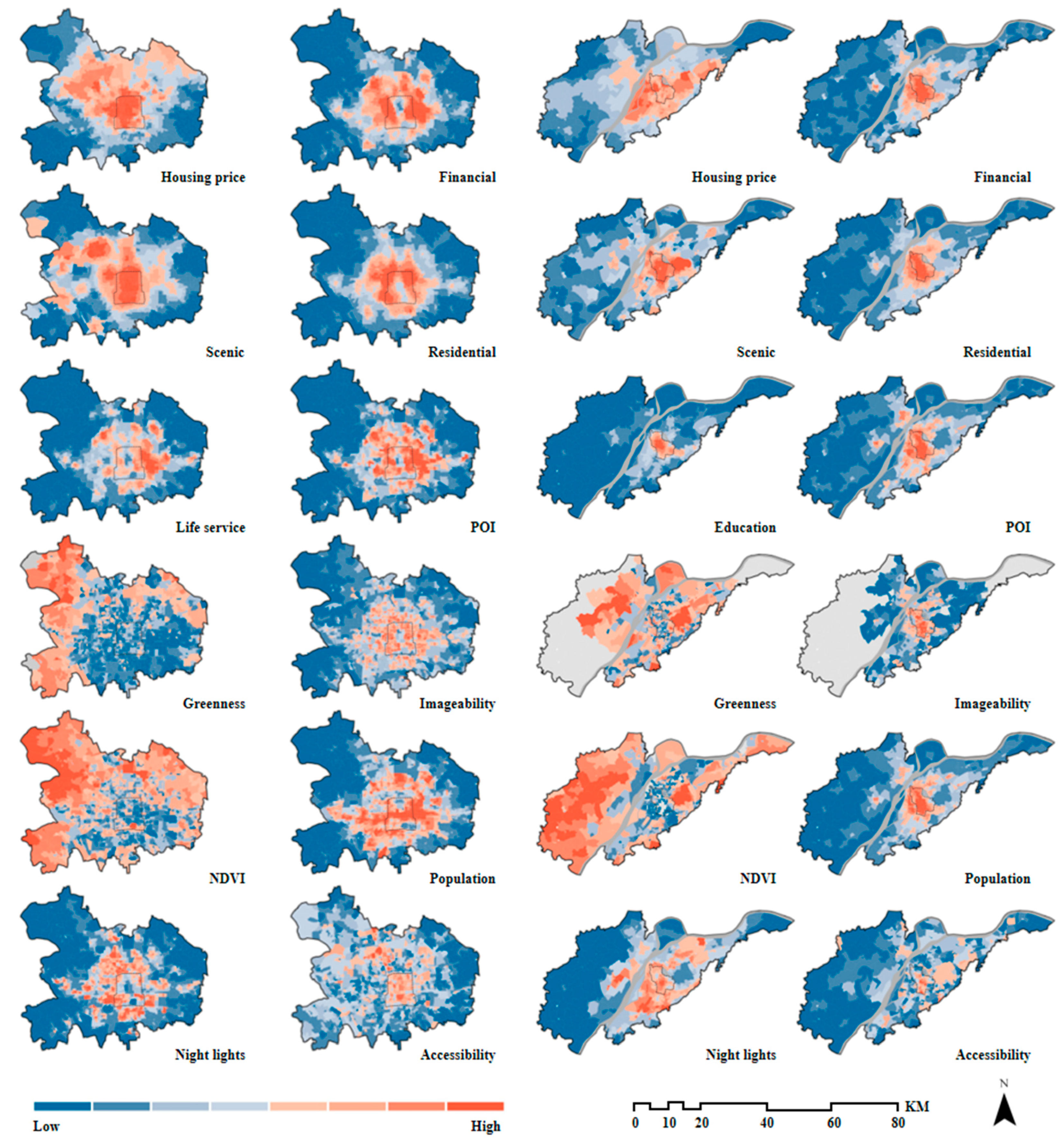
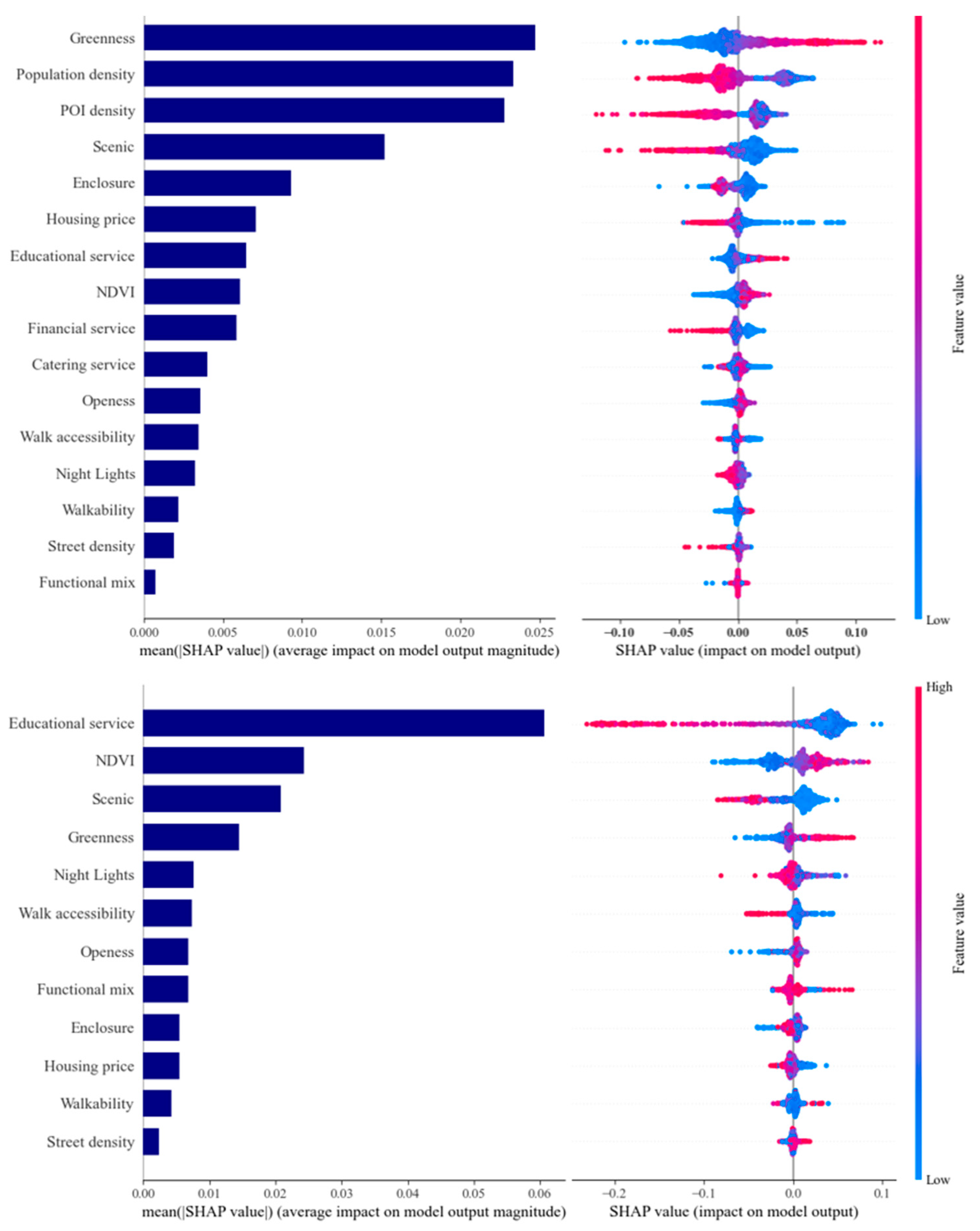

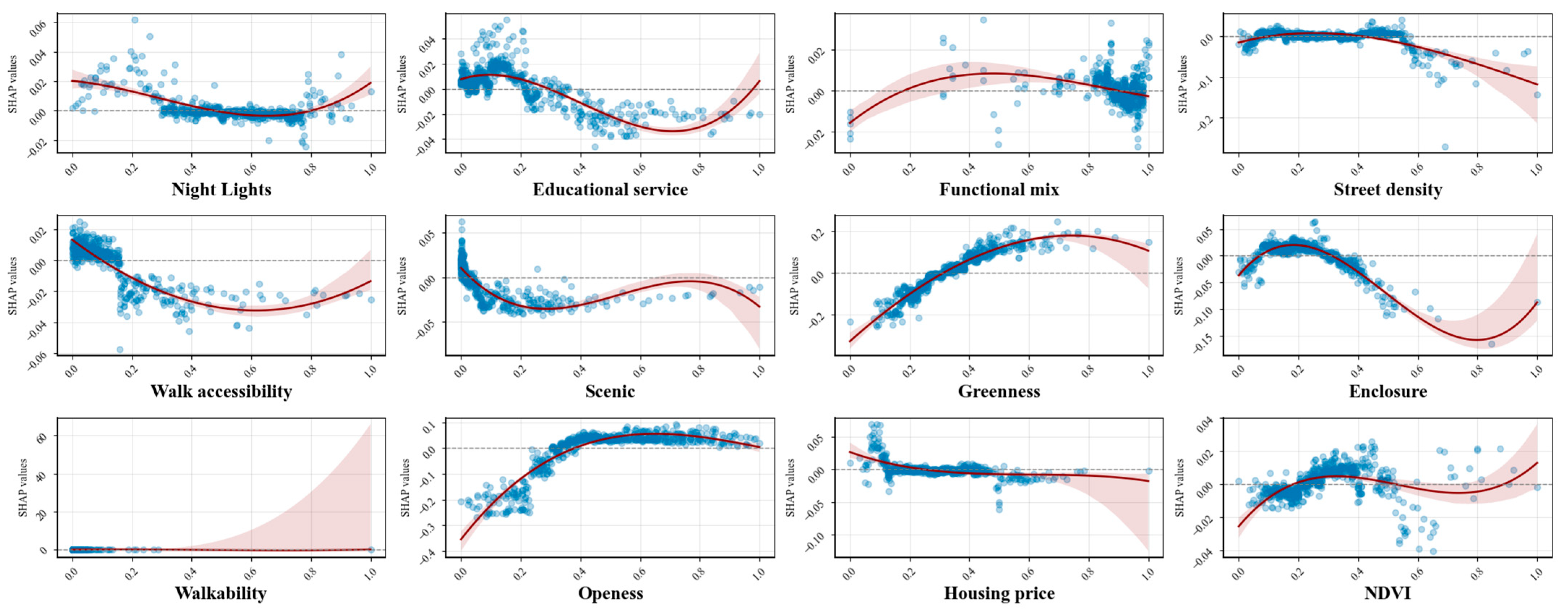
| Domains | Variables | Definition and Formula |
|---|---|---|
| Macroscale BE | ||
| Street density | Dstreet = Lroad/Scommunity | |
| Walk accessibility | 500 m road accessibility for segment modelling in DepthmapX | |
| Residential density | Kernel density of residences in GIS | |
| Life service density | Kernel density of life services in GIS | |
| Traffic station density | Kernel density of traffic stations in GIS | |
| Scenic density | Kernel density of scenic areas in GIS | |
| Financial service density | Kernel density of financial services in GIS | |
| Educational service density | Kernel density of educational services in GIS | |
| Medical service density | Kernel density of medical services in GIS | |
| Government agency density | Kernel density of government agencies in GIS | |
| Catering service density | Kernel density of catering services in GIS | |
| POI density | Kernel density of poi facilities in GIS | |
| Functional mix index | ||
| NDVI | ||
| Economic Indicators | ||
| Housing price | Empirical Bayesian chriskin interpolation in GIS | |
| Night Lights index | ||
| Population density | Kernel density of population in GIS | |
| Microscale BE | ||
| Greenness | ||
| Enclosure | ||
| Walkability | ||
| Imageability | ||
| Openness |
| Beijing | Nanjing | ||||||
|---|---|---|---|---|---|---|---|
| Variables | Mean | Std. Dev | VIF | Variables | Mean | Std. Dev | VIF |
| Street density | 0.362 | 0.171 | 2.02 | Street density | 0.299 | 0.181 | 2.13 |
| Walk accessibility | 0.190 | 0.146 | 1.77 | Walk accessibility | 0.125 | 0.155 | 3.62 |
| Scenic density | 0.116 | 0.043 | 2.84 | Scenic density | 0.008 | 0.153 | 2.19 |
| Financial service density | 0.133 | 0.134 | 2.87 | - | - | - | - |
| Educational service density | 0.092 | 0.116 | 1.57 | Educational service density | 0.193 | 0.205 | 2.58 |
| Catering service density | 0.236 | 0.150 | 4.53 | - | - | - | - |
| POI density | 0.197 | 0.124 | 4.97 | - | - | - | - |
| Functional mix index | 0.902 | 0.070 | 1.05 | Functional mix index | 0.884 | 0.134 | 1.14 |
| NDVI | 0.302 | 0.132 | 3.34 | NDVI | 0.288 | 0.150 | 3.96 |
| Housing price | 0.333 | 0.183 | 3.40 | Housing price | 0.294 | 0.138 | 1.57 |
| Night Lights index | 0.296 | 0.103 | 2.35 | Night Lights index | 0.531 | 0.183 | 2.22 |
| Population density | 0.273 | 0.103 | 2.80 | - | - | - | - |
| Greenness | 0.187 | 0.121 | 2.50 | Greenness | 0.337 | 0.137 | 1.67 |
| Enclosure | 0.008 | 0.361 | 1.01 | Enclosure | 0.229 | 0.124 | 3.21 |
| Walkability | 0.005 | 0.053 | 1.03 | Walkability | 0.016 | 0.049 | 1.09 |
| Openness | 0.470 | 0.172 | 2.56 | Openness | 0.477 | 0.216 | 4.26 |
| Model | |||||
|---|---|---|---|---|---|
| City | OLS | SEM | RF | GBDT | XGBoost |
| Beijing-R2 | 0.50 | 0.61 | 0.71 | 0.71 | 0.73 |
| Nanjing-R2 | 0.58 | 0.67 | 0.75 | 0.78 | 0.81 |
Disclaimer/Publisher’s Note: The statements, opinions and data contained in all publications are solely those of the individual author(s) and contributor(s) and not of MDPI and/or the editor(s). MDPI and/or the editor(s) disclaim responsibility for any injury to people or property resulting from any ideas, methods, instructions or products referred to in the content. |
© 2025 by the authors. Licensee MDPI, Basel, Switzerland. This article is an open access article distributed under the terms and conditions of the Creative Commons Attribution (CC BY) license (https://creativecommons.org/licenses/by/4.0/).
Share and Cite
Zhu, Y.; Liu, J. Revealing the Mismatch Between Residents’ SWB and Residential Environment Quality in Old and New Urban Areas: Community-Level Evidence from Two Historic Cities in China. Buildings 2025, 15, 4135. https://doi.org/10.3390/buildings15224135
Zhu Y, Liu J. Revealing the Mismatch Between Residents’ SWB and Residential Environment Quality in Old and New Urban Areas: Community-Level Evidence from Two Historic Cities in China. Buildings. 2025; 15(22):4135. https://doi.org/10.3390/buildings15224135
Chicago/Turabian StyleZhu, Yu, and Jie Liu. 2025. "Revealing the Mismatch Between Residents’ SWB and Residential Environment Quality in Old and New Urban Areas: Community-Level Evidence from Two Historic Cities in China" Buildings 15, no. 22: 4135. https://doi.org/10.3390/buildings15224135
APA StyleZhu, Y., & Liu, J. (2025). Revealing the Mismatch Between Residents’ SWB and Residential Environment Quality in Old and New Urban Areas: Community-Level Evidence from Two Historic Cities in China. Buildings, 15(22), 4135. https://doi.org/10.3390/buildings15224135





